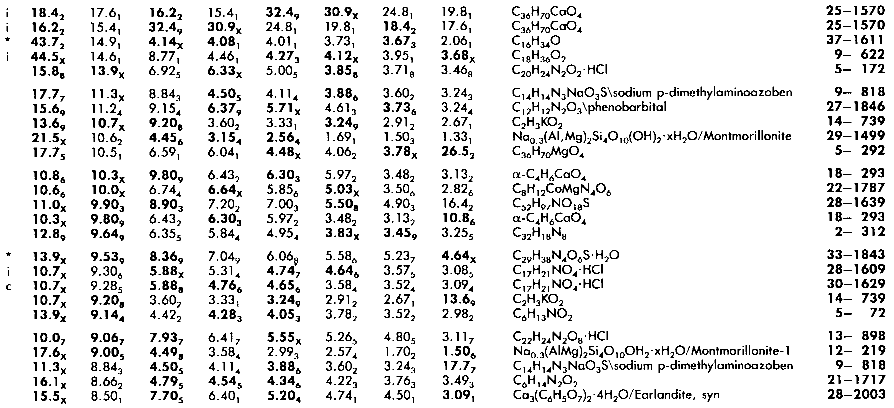 |
And Something More |
 Course Material Index
Course Material Index
 Section Index
Section Index
 Previous Page
Previous Page
 Next Page
Next Page
And Something More
The last example illustrates an important point: By using a priori knowledge of
the sample, in this case that it was probably a pure metal, the bounds of the
search could, at least in the first instance, be reduced from around 100000 to
just a dozen or so. Clearly it is important that such information be exploited
in search methods be they manual or computer-aided. For the former case a
number of manual sub-directories of the PDF have been compiled at various
times, such as:
- inorganic phases
- organic and organometallic phases
- minerals
- forensics
- metals and alloys
Another useful sub-directory is the Alphabetic Index in which phases can
be searched by chemical name or by mineral or other known description. This
might not at first sight seem so useful as the above, however many
practitioners (including this author) find it to be the most useful
sub-directory of all since they often have a hunch concerning a potential
candidate (which they will therefore want to seek out rather by its name) and
also since it is simply a very useful starting point for general information on
any crystalline material.
The earliest computer-aided search/match strategies were developed in times
(pre-seventies) when typical powder diffraction data (both the unknown and the
PDF database entries) suffered from relatively large errors in both
d spacings and intensities. Thus large error windows had to be placed on
the d-I values and the search was invariably exhaustive, even
across the whole database (which then was smaller of course). With improving
diffraction techniques, the accuracy of powder diffraction data has improved
enormously but the database has grown and the complexity of samples has
increased. More intelligent computer search/match strategies have been devised,
such as the use of:
- Hanawalt-type approach;
- Boolean search methods;
- Use of a FOM (Figure of Merit) to assess the goodness of match;
- Hierarchical searches, such as starting with the 300 most commonly
encountered phases in the PDF, then the 2500 most encountered and so on;
- Special methods for multi-phases (see later);
- Incorporation of chemical composition data.
The last item is particularly useful: Often the case might be that one will
know something about the chemical composition from the sample history (e.g. how
it was made, where it was found) and simply being able to say that it contains
calcium, sulphur, or whatever, is invaluable information towards cutting down
the bounds of the search.
Another index that should be briefly mentioned, since it has been well used in
some quarters over the years, is the Fink index which is named after a chairman
of the earlier JCPDS committee. This method is particularly appropriate for
those cases where it is inadvisable to place too much reliance on the
intensities, for example when
- there is significant preferred orientation in the sample;
- the powder pattern has been obtained by electron diffraction.
To counter these difficulties the Fink index has been designed to place greater
reliance on the actual values of the d spacings by using the 8 (rather
than 3) strongest lines. However the number of permutations with 8 lines is too
high so various compromises have been made concerning how multiple entries of
each Fink combination are entered into the Fink Search Manual. The figure below
illustrates a section taken from a typical Fink index in which the 4 strongest
lines appear in bold and each have a turn at being first.

©ICDD 1976. Used with
permission from the International Centre for Diffraction Data.
 Course Material Index
Course Material Index
 Section Index
Section Index
 Previous Page
Previous Page
 Next Page
Next Page


